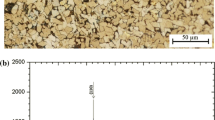Abstract
Formation characteristic of CO2 corrosion product layer on the surface of P110 steel was investigated in simulated oilfield environment using mass-loss experiment, potentiodynamic polarization curve, impedance spectroscopy, and SEM micrograph analysis. Samples of different times up to 240 h were tested during exposure. Corrosion product was primarily composed of Fe(Ca, Mg)(CO3)2, which was distinguished by two layers. With an increase in the exposure time, the charge transfer resistance and polarization resistance increased progressively, the uniform corrosion rate decreased, and the corrosion reaction was controlled by the diffusion process instead of the activation process. All phenomena were attributed to the formation of the protective corrosion product layer. More compact and lower porosity of the layer made it more difficult to transfer and diffuse through the corrosion product layer for the charges and ions. Similar results were obtained by electrochemical test and mass-loss experiment.
Similar content being viewed by others
References
Anderko A. Young R D. Simulation of CO2/H2S Corrosion Using Thermodynamic and Electrochemical Models [A]. NACE, eds. Corrosion/99 [C]. Houston; The Corrosion Society, 1999. 31.
Masakatsu Ueda, Hideki Takabe. Effect of Environmental Factors and Microstructure on Morphology of Corrosion Products in CO2 Environments [A]. NACE, eds. Corrosion/99 [C]. Houston: The Corrosion Society, 1999, 13.
Hesjevik S M, Olsen Statoil S, Seiersten Marion. Corrosion at High CO2 Pressure [A]. NACE, eds. Corrosion/2003 [C]. Houston; The Corrosion Society, 2003, 03345.
Rajappa S, Zhang R, Gopal M. Modeling the Diffusion Effects Through the Iron Carbonate Layer in the Carbon Dioxide Corrosion of Carbon Steel [A], NACE, eds. Corrosion/1998 [C]. Houston: The Corrosion Society, 26.
Guo X P, Tomoe Y. The Effect of Corrosion Product Layers on the Anodic and Cathodic Reactions of Carbon Steel in CO2-Saturated MDEA Solutions at 100°C [J]. Corrosion Science, 1999, 41(7): 1391.
Heuer J K, Stubbins J F. An XPS Characterization of FeCO3 Films From CO2 Corrosion [J]. Corrosion Science, 1999, 41 (7): 1231.
Marina Cabrin, Gazmend Hoxha, Ardjan Kopliku, et al. Prediction of CO2 Corrosion in Oil and Gas Wells. Analysis of Some Case Histories [A]. NACE, eds. Corrosion/98 [C]. Houston: The Corrosion Society, 1998. 24.
Schmitt G. CO2 Corrosion of Steels—An Attempt to Range Parameter and Their Effects [A]. NACE, eds. Advances in CO2 Corrosion [C]. Houston: The Corrosion Society, 1984. 1.
Gray L G S, Anderson B G, Danysh M J, et al. Mechanism of Carbon Steel Corrosion in Brines Containing Dissolved Carbon Dioxide at PH4 [A]. NACE, eds. Corrosion/89 [C]. Houston; The Corrosion Society, 1989, 464.
Waard C De, Milliams D E. Carbonic Acid Corrosion of Steel [J]. Corrosion, 1975, 31(5): 131.
Ikeda A, Ueda M, Mukai S, et al. Advances in CO2 Corrosion [A]. NACE, eds. Advances in CO2 Corrosion Vol. 1 [C]. Houston: The Corrosion Society, 1984, 39.
Idem K. Predicting COz Corrosion in the Oil and Gas Industry [A], The Institute of Materials, eds. Working Party Report [C]. London; The European Federation, 1994. 144.
Liu C, Bi Q, Leyland A, et al. An Electrochemical Impedance Spectroscopy Study of Corrosion Behavior of PVD Coated Steels in 0.5 N NaCl Aqueous Solution: Part I . Establishment of Equivalent Circuits for EIS Data Modeling [J]. Corrosion Science, 2003, 45(6): 1243.
Macdonald J R. Impedance Spectroscopy-Emphasising Solid Materials and Systems [J]. Corrosion Engineering, 1987, 32: 17.
Jae Sun Baek, Jung Gu Kim, Do Haeng Hur, et al. Anodic Film Properties Determined by EIS and Their Relationship With Caustic Stress Corrosion Cracking of Alloy 600 [J]. Corrosion Science, 2003, 45(5): 983.
CAO Chu-nan, ZHANG Jian-qing. Introduction of Electrochemical Impedance Spectra [M]. Beijing: Science Press, 2002 (in Chinese).
Author information
Authors and Affiliations
Rights and permissions
About this article
Cite this article
Zhao, Gx., Lu, Xh., Xiang, Jm. et al. Formation characteristic of CO2 corrosion product layer of P110 steel investigated by SEM and electrochemical techniques. J. Iron Steel Res. Int. 16, 89–94 (2009). https://doi.org/10.1016/S1006-706X(09)60067-4
Revised:
Published:
Issue Date:
DOI: https://doi.org/10.1016/S1006-706X(09)60067-4




